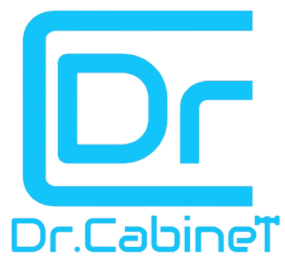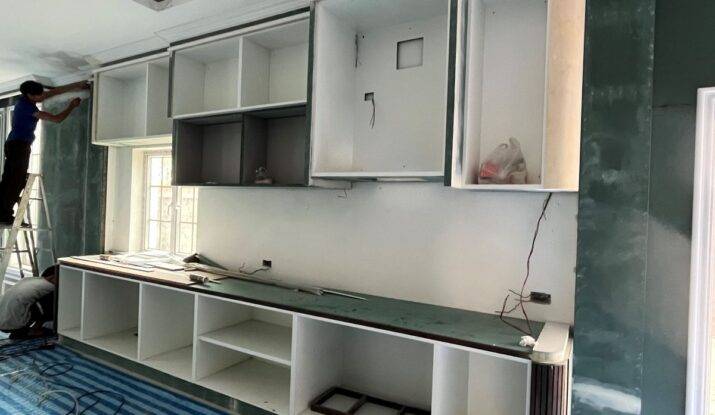Tired of your kitchen looking dated, but don’t want the hassle (or cost) of ripping everything out? Resurfacing your cabinet might be your best option. But what is cabinet resurfacing exactly? We’ll explain this in detail ahead, so keep reading!
Cabinet resurfacing gives your current kitchen cabinets a brand new look without the mess of a complete remodel, as opposed to replacing them completely. Consider it a kitchen makeover. Your kitchen looks brand new after you replace the worn-out drawer fronts and doors and apply a fresh finish, all while keeping the sturdy cabinet boxes. It’s cheaper than a full cabinet replacement, way faster, and way less wasteful. Additionally, you won’t have to put up with weeks of contractors demolishing your home.
It is a more sensible approach to upgrading—no demolition, no huge costs. So, before you start pricing out new cabinet boxes, check out how cabinet resurfacing can give your kitchen a fresh start—without the headache.
What Is Cabinet Resurfacing?
Let’s dig deeper into what is cabinet resurfacing. A facelift to your kitchen without the major surgery! The basic idea is to replace only the visible components of your existing cabinets, leaving the sturdy boxes and frames intact. That means:
- Swapping out old cabinet doors for fresh ones
- Updating drawer fronts so they match
- Giving everything else a good sanding and fresh coat of paint or stain
Is it same as Cabinet Refacing or Cabinet Refinishing?
Now, don’t mix this up with cabinet refacing or refinishing- that are its fancy cousins where they might glue thin wood veneer over everything or simply paint for a refinishing job. Resurfacing is done more straightforwardly; if it is broken then replace it. If it looks ugly, then just cover it up.
The magic? While everything that is visible gets a complete makeover, your structurally sound cabinets remain intact. What was once worn out will look brand new and contemporary without any fear of it wearing out.
Best part? You’re not stuck with how things were. Want to go from oak to sleek white? Traditional to modern slab doors? Resurfacing is the answer. It changes the look but keeps your favorite kitchen layout exactly the same.
Cabinet Resurfacing vs. Full Replacement: Which is better?
What is cabinet resurfacing? Is it different from a full cabinet replacement?
Save Money: It is cost-effective. Going the full replacement route means you’re paying for all new cabinet boxes – and trust me, that bill adds up fast. We’re talking 2-3 times more than what cabinet resurfacing would run you. Why shell out for brand new layout when your current setup still works fine?
Saves Time: Time is money too. A full gut job means your kitchen’s out of commission for weeks – contractors everywhere, dust in your coffee, takeout containers piling up. Resurfacing? Most jobs wrap up in just a few days. You’ll be making dinner in your “new” kitchen before you know it.
Eco-friendly: Here’s something most people don’t think about – going green saves you green. Tossing perfectly good current cabinets is like throwing money in the dumpster. Resurfacing keeps tons of material out of landfills, and let’s be real – that’s just smart these days.
Bottom line? Unless your cabinets are literally falling apart (and we mean termites-chewed-the-corners falling apart), resurfacing gives you 90% of the wow factor for half the cost and a fraction of the hassle. Smart homeowners know when to replace and when to refresh – this is definitely a refresh situation.
How Cabinet Resurfacing Actually Works
Have you ever wondered what actually goes on when a cabinet is resurfaced? Knowing the process will help you understand what is cabinet resurfacing eventually. It’s not very complicated. The actual breakdown is as follows:
Step 1: Checking up Cabinet Boxes & Face Frames
First things first – we gotta make sure your current setup isn’t falling apart. A pro will poke around your cabinet boxes and frames, making sure everything’s solid.
Step 2: Removing the Old Cabinet Doors and Drawer Fronts
Those old doors and drawers? Gone. We’ll carefully remove doors and hardware. This is where it starts feeling real – watching those 90s oak monstrosities hit the curb is downright therapeutic.
Step 3: The Kitchen Cabinets Makeover Begins
Now the fun part. We’ve got options:
- Sand and stain for a natural wood refresh
- Paint for a crisp, clean look
- Reface cabinets with laminate or with wood veneer if you’re feeling modern
Step 4: Brand New Cabinet Doors and Cabinet Frames
This is where your kitchen’s personality comes through. Pick a door style that matches your vibe – shaker for classic, slab for modern. Then we’ll modify it with new knobs and handles that match (unlike the random collection being used).
Step 5: The Final Touch
Final touches would be added to make it more appealing:
- Crown molding to fancy it up
- Fresh drawer pulls that don’t wobble
- Any quick fixes needed to keep everything sturdy
The whole process moves fast – we’re talking days, not weeks. One week you’re embarrassed to have guests over, the next you’re showing off your “new” kitchen. Best part? No demolition dust in your cereal.
Why Smart Homeowners Choose Cabinet Resurfacing
Let’s be real – kitchen remodels can drain your wallet and your patience. That’s where cabinet resurfacing shines. Check out these perks:
1. Your Wallet Stays Happy
Why blow $15k on all-new cabinets when resurfacing does the job for a fraction of the cost? We’re talking serious savings here – like “still afford your summer vacation” kind of savings. The secret? You’re only replacing what people actually see, not the perfectly good bones of your cabinets.
2. Done Before You Know It
Full kitchen remodels turn your life upside down for months. Resurfacing? More like a long weekend. No living off microwave meals, no contractors tracking mud through your house for weeks. One Friday your kitchen looks tired, by Monday it’s got a fresh new attitude.
3. Make It Uniquely Yours
This isn’t some cookie-cutter solution. Want sleek modern slabs? Classic shaker style? Moody navy or crisp white? Or simply want to add storage? Go for it. Swap out hardware, add glass inserts, or go wild with exotic veneers. It’s your kitchen’s glow-up – you call the shots.
Is Cabinet Resurfacing Right For You?
Let’s cut to the chase – resurfacing isn’t for every kitchen. Here’s how to know if it’s your golden ticket:
Your cabinets are ugly, not useless
If your doors are stuck in the 90s but the boxes aren’t falling apart, perfect. We’re talking solid frames that just need a facelift. But if they’re water-damaged or hanging by one screw? That’s a replacement situation.
You like where everything is
Happy with your kitchen’s flow? Resurfacing keeps your current setup while ditching the dated look. No moving plumbing or electrical – just a fresh face on your existing finish.
You want a remodel without the chaos
Planning a bigger kitchen update? Pair resurfacing with freshly installed kitchen countertops or backsplash for maximum impact and little demolition. It is the smart makeover’s hidden weapon.
Quick reality check:
- ✅ Solid boxes + ugly doors = Resurface
- ❌ Rotten frames + layout changes = Replace
What Does Cabinet Resurfacing Really Cost?
Nobody likes surprise bills. Here’s the real deal on what you’ll pay to transform those tired cabinets:
The Price Tag
Most jobs run $1,500-$5,000 for a standard kitchen. Depending on your level of luxury, that can range from $30 to $150 per linear foot. As opposed to $5,000–15,000 for brand-new cabinets? Yes, the savings are self-evident.
What Influences the Cost?
Door style matters: Basic slab doors won’t break the bank, but custom Shaker or inset designs? That’s where prices climb
Material choices: Laminate keeps costs down, while real wood veneer adds luxury (and dollars)
Labor intensity: A simple paint refresh costs less than completely new doors and drawer fronts
- Comparing apples to apples, resurfacing is 60–70% less expensive than complete replacement.
- New doors only: About half the cost of resurfacing (but doesn’t address the boxes)
DIY route: Could save 50%, but let’s be honest – most of us aren’t cabinet pros
Pro tip: The sweet spot? Mid-range materials with professional installation. You get 90% of the wow factor without the premium price tag. Just remember – cheap now often means paying more later when finishes chip or warp.
DIY or Call the Pros for Cabinet Resurfacing?
What is cabinet resurfacing and whether you should do it yourself or hire someone? Here is how to choose what’s right for you:
The DIY Route (For the Brave Souls)
Pros:
- Save serious cash (we’re talking 50-70% off pro prices)
- Total creative control – want neon pink cabinets? Go wild
- That sweet sense of accomplishment when you’re done
Cons:
- It’s WAY more work than YouTube makes it look
- Messy as hell (paint dust everywhere forever)
- Easy to screw up (streaky finishes, existing doors that don’t close right)
- Might actually decrease your home’s value if done poorly
Hiring Professionals (For the Smart Cookies)
Why it’s worth it:
- These folks eat, sleep, and breathe cabinets – they know tricks you don’t
- Factory-quality finishes that actually last
- Done in days, not months, of weekends
- Often comes with warranties (good luck getting Home Depot to warranty your DIY job)
The secret sauce? Most good cabinet companies offer free consultations. They’ll tell you straight-up if your cabinets are DIY material or need pro help. Might as well get their take before you commit to a project that could turn into a nightmare.
Wrapping Up: Cabinet Resurfacing – The Smart Choice
Let’s face it, most of us lack the funds and time necessary for a complete kitchen makeover. When you know what is cabinet resurfacing, you understand how revolutionary it is because of covering these issues. For a lot less money and effort, you can get a new, contemporary look without tearing out perfectly good cabinets. Fresh finishes, new doors, and no hassles associated with demolition.
Consider this:
- Save thousands compared to full replacement
- Skip the chaos—no weeks of contractors in your kitchen.
- Use styles that actually go along with your vibe.
Resurfacing is the best thing if your cabinets simply need a modern makeover. Why pay the price of something new when you can simply alter what you already own?
Cabinet Refacing & Resurfacing FAQs
Is cabinet resurfacing just another name for refacing kitchen cabinets?
No! They are two different things. Resurfacing involves replacing cabinet doors and drawers while refinishing existing cabinet boxes. Refacing applies new laminate veneer or materials over the existing surface of cabinet fronts and cabinet sides.
Will my recently resurfaced cabinets peel within a year?
Not if done professionally! Quality cabinet makers ensure refinishing cabinets lasts 10–15 years—about as long as new cabinetry. The key? Proper prep work and durable materials. DIY jobs may fail sooner.
Can I switch from traditional to modern door design?
Absolutely! Refacing kitchen cabinets lets you update styles easily. However, dramatic changes (like slab doors) may require fixing structural frames.
How much do I save vs. full replacement?
Typically 50–70% less! Cabinet refacing cost averages $5K–$7K, while new cabinets can hit $15K+. Savings grow with larger kitchens or a different layout.
What finish resists children, dogs, and cooking messes the best?
Many homeowners prefer:
Thermofoil = Most durable, easiest clean
Painted MDF = Great mid-range option
Stained wood = Shows wear faster but can be touched up for new life






